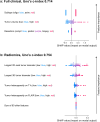Survival prediction with radiomics for patients with IDH mutated lower-grade glioma
- PMID: 40100522
- PMCID: PMC12170745
- DOI: 10.1007/s11060-025-05006-z
Survival prediction with radiomics for patients with IDH mutated lower-grade glioma
Abstract
Purpose: Adult patients with diffuse lower-grade gliomas (dLGG) show heterogeneous survival outcomes, complicating postoperative treatment planning. Treating all patients early increases the risk of long-term side effects, while delayed treatment may lead to impaired survival. Refinement of prognostic models could optimize timing of treatment. Conventional radiological features are prognostic in dLGG, but MRI could carry more prognostic information. This study aimed to investigate MRI-based radiomics survival models and compare them with clinical models.
Methods: Two clinical survival models were created: a preoperative model (tumor volume) and a full clinical model (tumor volume, extent of resection, tumor subtype). Radiomics features were extracted from preoperative MRI. The dataset was divided into training set and unseen test set (70:30). Model performance was evaluated on test set with Uno's concordance index (c-index). Risk groups were created by the best performing model's predictions.
Results: 207 patients with mutated IDH (mIDH) dLGG were included. The preoperative clinical, full clinical and radiomics models showed c-indexes of 0.70, 0.71 and 0.75 respectively on test set for overall survival. The radiomics model included four features of tumor diameter and tumor heterogeneity. The combined full clinical and radiomics model showed best performance with c-index = 0.79. The survival difference between high- and low-risk patients according to the combined model was both statistically significant and clinically relevant.
Conclusion: Radiomics can capture quantitative prognostic information in patients with dLGG. Combined models show promise of synergetic effects and should be studied further in astrocytoma and oligodendroglioma patients separately for optimal modelling of individual risks.
Keywords: Glioma; Magnetic resonance imaging; Radiomics; Survival analysis.
© 2025. The Author(s).
Conflict of interest statement
Declarations. Ethics approval and consent to participate: The study was conducted in accordance with the Declaration of Helsinki. Regional Ethical Review Board in Gothenburg, Sweden (Dnr: 702 − 18, Dnr: 705 − 17) approved the study. Competing interests: The authors declare no competing interests. Consent to participate: Written informed consent was signed by the patients which were included prospectively. The ethical committee waived the need of informed consent for retrospectively included patients.
Figures



Similar articles
-
Predicting the molecular subtypes of 2021 WHO grade 4 glioma by a multiparametric MRI-based machine learning model.BMC Cancer. 2025 Jul 14;25(1):1171. doi: 10.1186/s12885-025-14529-7. BMC Cancer. 2025. PMID: 40660102 Free PMC article.
-
Deep Learning and Habitat Radiomics for the Prediction of Glioma Pathology Using Multiparametric MRI: A Multicenter Study.Acad Radiol. 2025 Feb;32(2):963-975. doi: 10.1016/j.acra.2024.09.021. Epub 2024 Sep 24. Acad Radiol. 2025. PMID: 39322536
-
Predicting p53 Status in IDH-Mutant Gliomas Using MRI-Based Radiomic Model.Cancer Med. 2025 Aug;14(15):e71063. doi: 10.1002/cam4.71063. Cancer Med. 2025. PMID: 40747552 Free PMC article.
-
Advanced MRI, Radiomics and Radiogenomics in Unravelling Incidental Glioma Grading and Genetic Status: Where Are We?Medicina (Kaunas). 2025 Aug 12;61(8):1453. doi: 10.3390/medicina61081453. Medicina (Kaunas). 2025. PMID: 40870498 Free PMC article. Review.
-
An analysis of 170 glioma patients and systematic review to investigate the association between IDH-1 mutations and preoperative glioma-related epilepsy.J Clin Neurosci. 2016 Sep;31:56-62. doi: 10.1016/j.jocn.2015.11.030. Epub 2016 Jul 9. J Clin Neurosci. 2016. PMID: 27406953
References
MeSH terms
Substances
LinkOut - more resources
Full Text Sources
Medical
Miscellaneous

